How Does Subscription Pricing Work?
Subscription pricing is when your business charges a recurring monthly fee in return for providing an ongoing service or regularly delivering a product.
The customer is charged a price for a specified period, usually a month or year. The amount they are charged during this period often depends on the amount of product or service they get.
This approach provides a range of benefits to the customer, including:
✔️ Making your product or service more affordable
✔️ Giving them the flexibility to cancel
✔️ Allowing them to use your product or service as much or as long as they need to
Why Use a Subscription Pricing Model?
Subscription pricing models also offer benefits to your business, including:
✔️ Predictable cash flow: If you know how many customers you have and your churn rate, then it’s easier to predict your cost and income.
✔️ Accessible products and services: Subscriptions are often cheaper than paying in full, giving customers a lower-risk option for buying your products and services.
✔️ Closer customer relationships: Because you regularly charge and deliver to customers, you get more opportunities to satisfy them.
✔️ Good upselling opportunities: You can offer additional subscription pricing tiers or add-on products or services. This ensures that customers can spend more if they so wish.
✔️ Source of data: Your regular interactions with customers give you a ton of data on their preferences and behaviors, allowing you to tailor offers to them.
Subscription Pricing Model Challenges
Subscription pricing models also have their challenges. They include:
⚠️ It’s easy for customers to switch: Subscription models often make it easy for customers to cancel. If you don’t provide great customer service, they may leave you for another provider. Customer retention, therefore, becomes a major business focus.
⚠️ Complexity: If you offer multiple pricing tiers, billing periods, and offerings, subscriptions can quickly become complex to manage.
⚠️ You need specialist tech: Most ecommerce sites can be built using standard platforms like Shopify. However, providing a subscription offer means you need to use plugins. These plugins often don’t work well. It will save you time and money to use a subscription-first platform.
Choosing a Subscription Pricing Strategy
Establishing your subscription pricing strategy is one of your most important decisions.
Here are some of the main types of subscription pricing models you can choose from:
➡️ Flat-rate pricing model
Also known as fixed pricing, a flat-rate pricing model is when you charge a single price.
This is possibly the easiest subscription pricing model to establish, as you only have to consider one value to charge.
Who the flat-rate pricing model suits:
You may choose this model if your product or service has limited features and a defined buyer persona.
Pros:
Due to its simplicity, this pricing model also gives you more time to focus on other areas of the business, like customer acquisition.
Cons:
Little room for variable offerings or addressing customers with higher or lower spending thresholds.
Example: Rocksbox
An example is Rocksbox, a jewelry rental subscription that offers subscribers three hand-selected pieces of jewelry per month—with preferences you can indicate—for a flat fee of $21 per month.
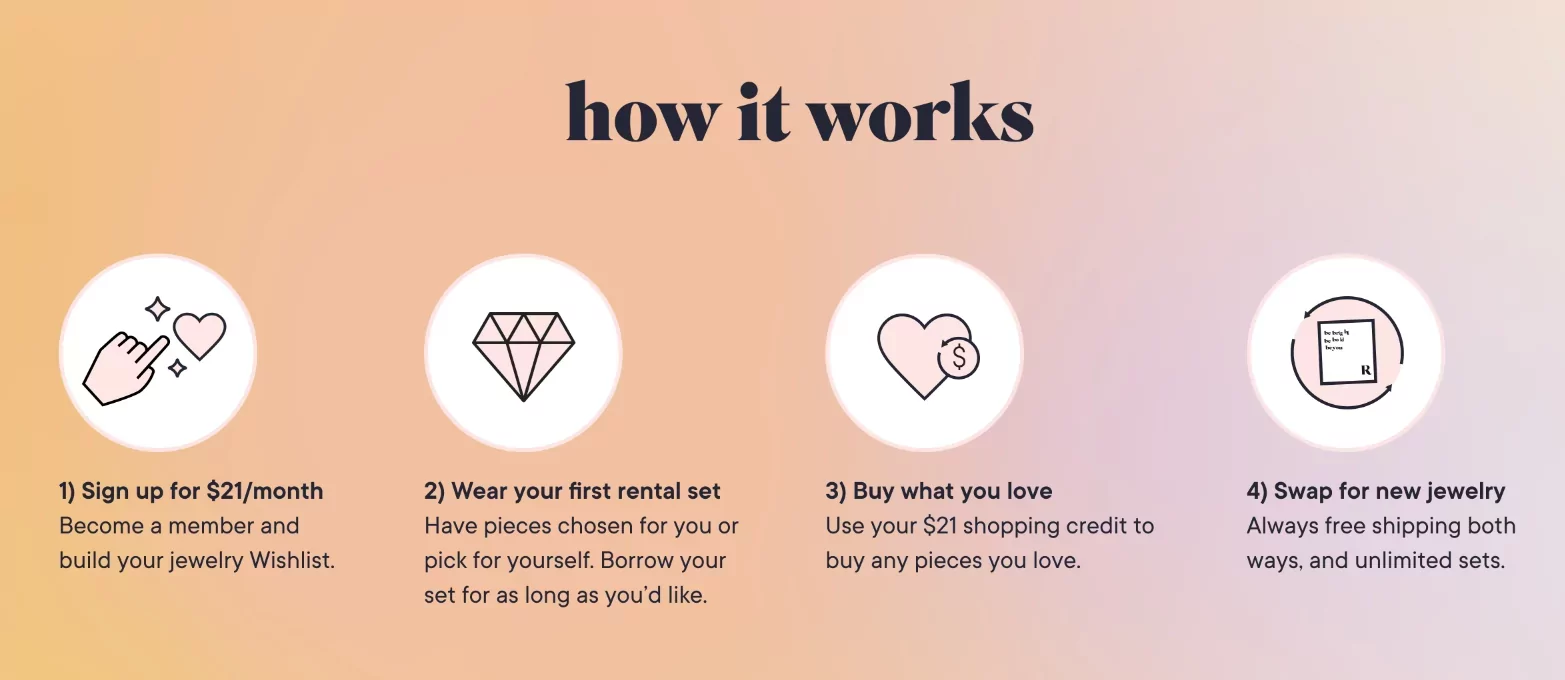
➡️ Tiered pricing model
Also called multiple-tier pricing, this subscription-based model allows you to offer several price points with different products and features at each.
Who the tiered pricing model suits:
Those targeting a diverse audience with a range of income levels or needs.
Pros:
Easy to upsell to the next tier if a customer loves the product or downgrade if they are unsure or facing financial issues.
Cons:
Working out where to draw the line between tiers can be challenging. Also, as mentioned earlier, dealing with multiple subscription tiers can become complex.
Example: Bitsbox
One such example is Bitsbox, an educational subscription box for children that offers its customers three separate tiers, with two ways of engaging with the product.
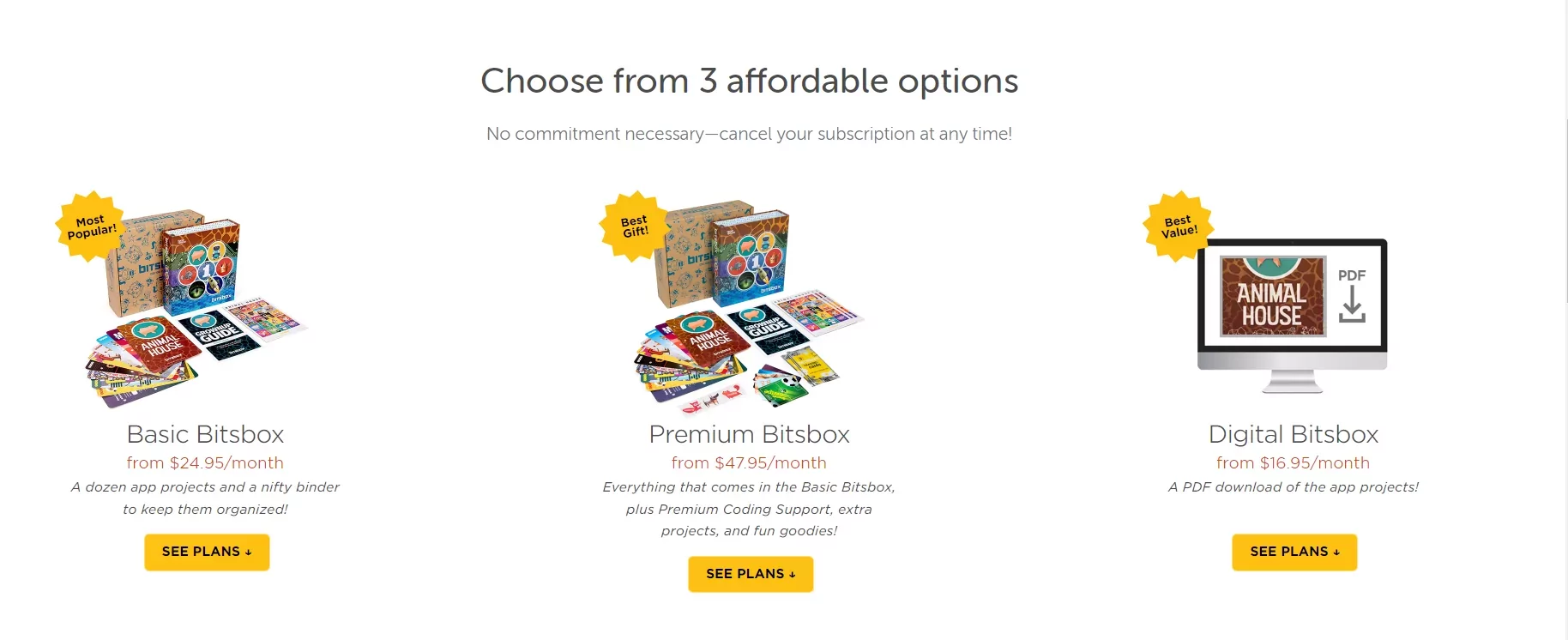
Another example is BusterBox, a pet products subscription that offers subscription tiers based on the length of your contract. The longer you sign up for, the cheaper each box is.

Source: BusterBox
Consider using a subscription box pricing table if your business offers subscription tiers. Such a table is a great way to showcase the differences between your boxes and make it easier for your customers to choose the best one.
A good example of a subscription box pricing table is Bump Boxes:
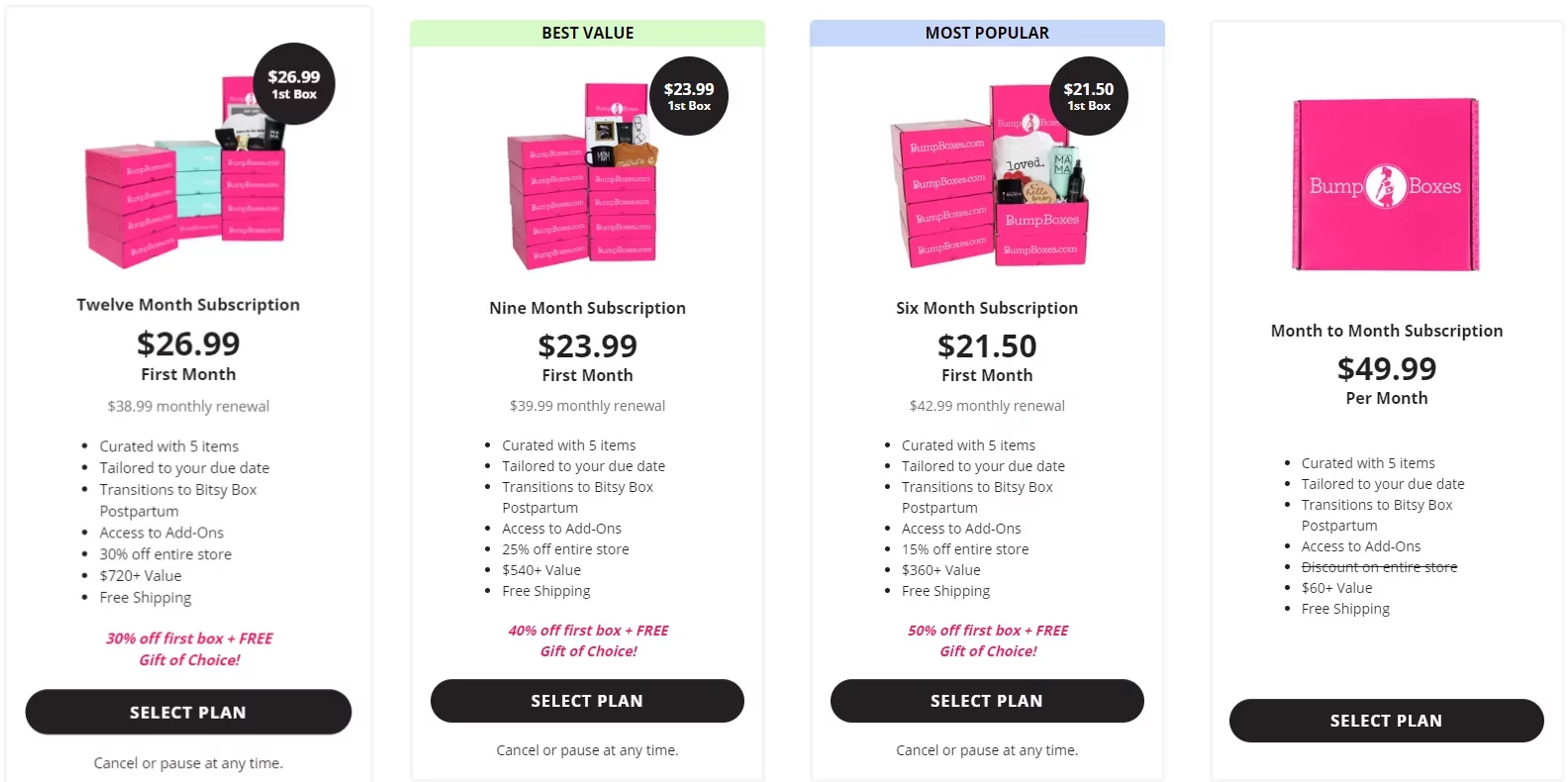
Source: Bump Boxes
➡️ Cost plus pricing model
In this model, you calculate the total cost of providing your product or service and then add a markup percentage, which ensures a decent profit margin.
Using the cost-plus model means you would add up all your costs, like:
➕ Materials
➕ Labor
➕ Equipment
➕ Subscriptions and licenses
Who the cost-plus model suits:
This strategy suits businesses where costs are relatively stable and predictable, like if you offer the same products each month.
For example, if you send the same coffee to your customers each month, you’ll know that your product cost will likely remain the same. You can then add your markup to calculate your final price.
It’s less suitable for businesses that sell easy-to-acquire products. For example, if you resell a product that people could easily buy directly from the supplier, then why would they buy from you at a higher cost?
Pros:
- Easy to project profits.
- You can justify your prices to customers.
Cons:
Competition could drive down your profit margin or make it hard to get new customers.
➡️ Competitor-based pricing model
Competitor-based pricing is when you set your subscription prices in line with the pricing structures of your competitors.
To implement a competitor-based pricing strategy, you need to conduct a market analysis to understand the pricing of subscription boxes similar to yours.
You can then choose how you want to position your box compared to your competitors in three ways:
Price matching
This involves setting your subscription box price to the same value as your competitors.
Price undercutting
A strategy that includes setting your box’s price slightly lower than your competitors to attract price-sensitive customers. This can also help you gain market share.
Premium pricing
In this case, you would set your subscription price higher than your competitors and market it as a premium alternative.
An example of a business that may be using premium pricing is Mouth. Their snacks subscription box is $40.95 per month.

Source: Mouth
Compare this to Munch Addict, which also provides a snack subscription box, but charges as little as $15.00.
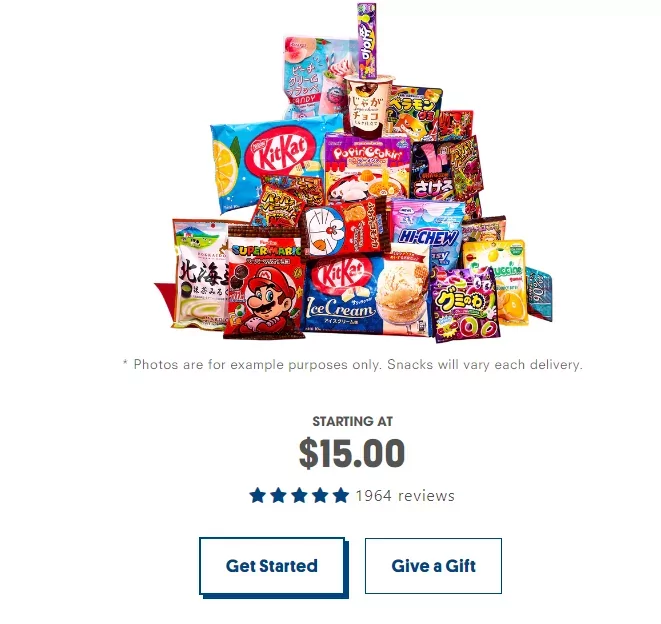
Source: Munch Addict
Who competitor-based pricing suits
This pricing strategy best suits companies that provide services or operate in a competitive niche.
Pros:
Low prices are a quick and eye-catching benefit to sell to customers. While premium pricing allows you to focus on delivering high value.
Cons:
Undercutting on price means you could become commoditized. Also, if your industry becomes too competitive, it can become a race to the bottom. Lower prices could eventually eat into product quality or your profit margin.
Using a premium model, on the other hand, could mean it takes longer to build up a customer base. Customers may be more likely to cancel during difficult times.
➡️ Value-based pricing model
Instead of basing your price on what it costs to pack and ship your subscription box, value-based pricing is based on your product’s perceived value to your customers.
This involves understanding what customers value most about your subscription box. You might need to conduct market research, customer interviews, and data analysis to understand perceived value.
Once you understand your customers, you can segment them into different groups and provide a tiered pricing structure that caters to each segment. The different price points for each tier would be based on the value your products deliver to the customer.
Who a value-based pricing model suits
This model suits businesses that sell luxury goods or those that offer B2B services that can improve efficiency or sales.
Pros:
Earnings per customer can be incredibly high.
Cons:
Industry changes mean that what a customer perceives as high value can quickly change.
Example: Bespoke Post
An example is Bespoke Post, which offers several subscription boxes, each aimed at a unique segment within its audience. These tend to be for luxury items that people within that segment would find useful.

Source: Bespoke Post
➡️ Freemium pricing model
In this model, you provide a free basic version of your product or service. However, enhanced or full use of the product requires a subscription.
For this to work, you must create a free tier offering that provides enough value for customers to use your products and build a relationship with your brand.
Who does a freemium pricing model suit?
This model is typically used in the software industry, where low cost of acquisition but high customer lifetime value make it a lucrative pricing strategy.
It rarely suits businesses that offer physical products or services, as the cost of providing them often makes a free tier impossible.
Pros:
A great way to build brand loyalty and attract customers. Plus, you benefit from getting large amounts of customer data for free.
Cons:
Freemium pricing can be expensive. You’ll have to serve people who may never convert to paying customers. Also, you might find user numbers drop rapidly if you remove or begin limiting your free pricing option.
Example: ChatGPT
Generative artificial intelligence chatbot ChatGPT has a limited free version. Users can upgrade to access unlimited use and a wider range of features. There’s also a paid business version that integrates with team workspaces.
The fact that ChatGPT is free has helped the company quickly become the world’s number one AI chatbot. More importantly, it has attracted tons of users, allowing the AI to learn quicker than it would have if it had fewer users but was more profitable.
The fact that it is free has also attracted developers who want to program it for business purposes. This has helped expand the market for AI tools and fuelled demand for the software.
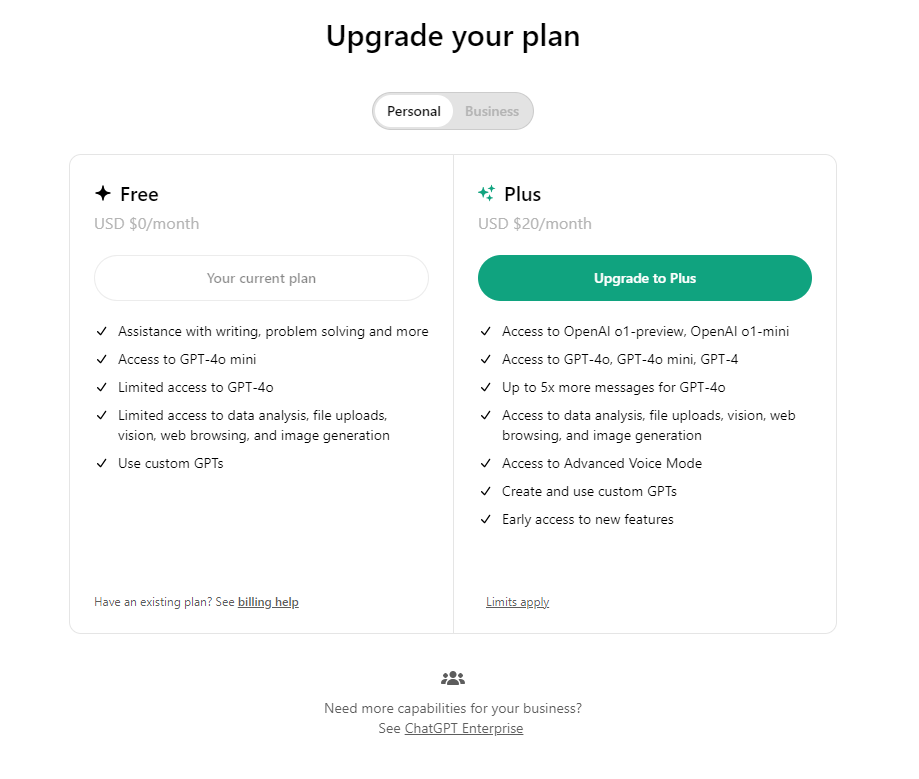
Source: ChatGPT
➡️ Usage-based model
A usage-based pricing model is when a subscription’s price is based on how much of your product a customer orders or uses.
For example, if you provide a subscription box service, you might charge customers based on the number of boxes they preorder per month or year.
Each price tier could involve ordering more boxes but at a lower price per box. This would encourage them to order more.
Alternatively, you might provide a cloud storage service that charges businesses based on the number of gigabytes of storage they use.
Who a usage-based pricing model suits:
Usage-based models suit any business where measuring how much of a product customers use is easy. Customers also need to get sufficient value from a limited amount of use.
A good example of a business that does not suit usage-based pricing is design software. Would you limit the number of exports? Or the amount of time customers can spend designing?
Pros:
Customers can choose a price point that suits their budget and needs. Plus, it’s often easy to reduce their spending simply by reducing usage.
Cons:
Customers may find it frustrating if they accidentally use too much of a service and get a bill shock. This often happens with cellphone contracts where customers accidentally use large amounts of data, for instance, when roaming.
Example: Blue Apron
An example of a subscription box service with a usage-based pricing model is Blue Apron.
The price you pay per box will change depending on how many meals you order weekly.

Which Industries Suit Subscription Pricing?
Not every industry suits subscription pricing. For example, you would sell subscriptions for bagless vacuum cleaners. The idea is that you buy one and it lasts for as long as possible.
Here are some examples of industries that suit subscription pricing models:
Subscription boxes
Subscription boxes are a subset of subscription businesses focused on curating a selection of products for customers.
Customers pay for and receive products tailored to their wants, needs, and budgets on a regular basis.
In exchange, they make regular payments to the subscription box business. Typically, customers can choose how often they want to receive their boxes.

Publications
Magazines and newspapers are some of the oldest examples of subscription pricing models. Customers pay a flat fee to get the publication delivered to them, usually on a monthly or quarterly basis.

Health and fitness
The classic example is a gym or leisure center. Customers pay a fee to access certain facilities for example, they might be able to get pool-only access or be able to use all facilities.
Other examples include fitness coaching or dieting membership groups like Weight Watchers. More recently, this industry has become dominated by mobile apps.

Source: WeightWatchers
Software-as-a-service (SaaS)
Software-as-a-service is when software is provided to users over the cloud on a subscription basis. This is opposed to the traditional approach where customers would install the software and then own it forever.
The pros of SaaS are that software subscriptions tend to be more affordable in the short term. However, in the long term, customers may end up paying more. Plus, they never own the software.
One of the most famous cases of a company that switched from selling packages to an SaaS model is Adobe and its creative suite.
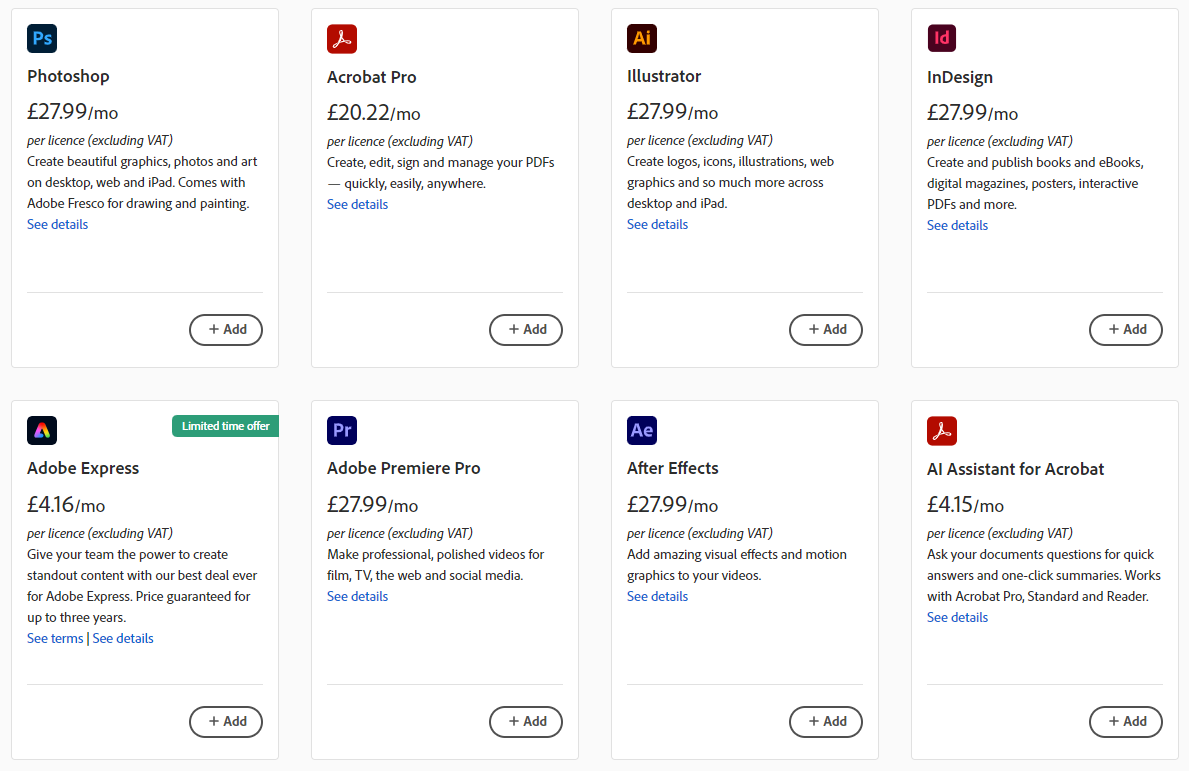
Source: Adobe
Streaming
Entertainment streaming services often provide several subscription pricing options. For example, the music streaming platform Spotify provides subscription payment options based on the number of users.

Source: Spotify
Mobile apps
Mobile apps often require a subscription to fully use. A good example of this is personal organization app Todoist. It has a freemium version, as well as paid and business versions.

Source: Todoist
How to Calculate Your Subscription Pricing
Now that you understand the different pricing models available, it is time to calculate the ideal price for your subscription business.
There are a few factors to consider when deciding how much to charge, but no hard and fast rules.
1. Understand The Market
💲 The industry average
The industry average is a useful starting point for deciding what price you should charge.
While you can’t set a price based solely on the industry average for subscriptions, it is important to understand how much customers are willing to pay for products or services similar to yours.
This gives you a benchmark against which to set your own price, as you don’t want to be the most expensive in your industry, but you don’t want to be the cheapest, either.
If you operate a subscription box business, then you might find the chart below useful. We conducted an in-depth study on industry averages by comparing the prices of thousands of subscription boxes in the U.S:

💲 Your customers
Before you can determine the price of your subscriptions, you need to analyze your customers.
First, identify the customer segments you cater to, their specific needs, preferences, and what they’d be willing to pay for your service.
You’ll also need to determine how customers will perceive the value of your subscriptions. This will help if you’re going to use a value-based pricing model.
Read our marketing guide to find out how to get to know your customers.
💲 Your product
You’ll need to understand your product or service’s perceived value before you can set a price.
If it is unique and unavailable from other subscription services, it can be perceived as more valuable, and you can charge more.
On the other hand, if your offering is fairly generic, you won’t be able to charge a higher price than competitors.
There are a number of other ways you can try to increase the perceived value of your offering, including:
- Making it seem scarce
- Emphasizing quality or authenticity
- Working on design to make the products more visually appealing
💲 Your competitors
You need to analyze your competitors, specifically those in your niche, and understand what they’re charging and the value of their subscriptions.
This is especially necessary if you’re opting for a competitor-based pricing model.
Analyzing your competitors will also give you a good idea of the demand for your product or service, which will impact the price you choose.
2. Understand Your Costs
💲 Product purchase price
If you are selling product subscriptions, then working out how much buying those products will cost is critical.
This is especially relevant if you buy wholesale and keep items in stock.
For example, if you are pricing wholesale products for subscription boxes, you can use the cost of these products to calculate a total product budget for your box and then be careful not to exceed that.
If you think that your product budget should remain stable over time, you could potentially use a cost-plus model to help you set a price for your subscription box.
💲 Packaging and box materials
Product presentation is important, but packing materials costs quickly add up.
For example, when calculating subscription box packaging costs, remember to include the price of the actual box, tissue paper, stickers, labels, and any other packing materials you’ll use to give your subscription box that ‘wow’ factor.
💲 Shipping, delivery, and fulfillment costs
Your shipping costs will vary based on the size and weight of your products and where they are being delivered.
Consider searching different addresses through your postal service to determine an average shipping cost.
You can then choose to include shipping in your pricing or charge an additional flat rate on top of the subscription price.
There are several ways to save money on shipping, such as:
- Using USPS’ commercial service: Commercial Plus bases price on volume instead of weight. This means you could save money if your box is heavier.
- Using slower shipping: The box may travel slowly, but you’ll ship it to the carrier earlier. This means paying less for shipping, and the customer still receives their box on time.
- Choosing a postal carrier closer to most of your customers: Look at which areas most of your subscribers live in and choose suppliers closest to those zones.
💲 Labor and fulfillment
Estimating your labor costs is important so that you’re not working for free.
This is especially important if you are providing a service or app, as most of your overheads will be wages.
If you provide products, then you might be happy to pack boxes yourself initially, but as your business grows, you will likely invest in an outsourced solution where your boxes are packed for you.
You’ll want to factor this in from the beginning of your subscription business to avoid increasing your prices later, which could lose you loyal customers.
💲 Transaction fees
Transaction fees from credit card payments can quickly accumulate, especially as you gain subscribers. That’s money that could be injected into your business instead.
Your transaction fees will vary based on the platform you’re using. If you don’t know what your credit card fees are, find out and consider factoring this into your subscription pricing.
💲 Customer acquisition and marketing costs
Whether you’re using social media paid ads, search engine optimization (SEO), flyers, or marketing emails, you need to know how much it costs to acquire new customers.
If you’ve hired a marketer, their service costs will also need to be factored in. If you’re doing your own marketing, then the cost of your time matters, too.
Customer acquisition costs may vary, and it’s an important subscription metric to track as it may fluctuate over time.
Be wary that you’re not paying more to attract customers than you can afford, whether that’s through offering products that are more premium than they need to be—a key consideration in product selection—or spending money on marketing channels that aren’t leading to conversions.
3. Decide on the Profit Margin for Your Subscription Box.
With all this information in mind, you can start estimating the right subscription pricing for your business. This is the point where you need to start considering your profit margin.
Two types of profit margins apply to your subscription business:
💲 Gross margin
This is your profit after direct product costs, but with non-product-related expenses (marketing, labor, and transaction fees) excluded. This doesn’t apply to businesses that provide a service.
💲 Net margin
This is what you take home at the end of the day—your profit after all costs associated with running your subscription box business were deducted. To calculate your net profit, you can use the formula below:
Revenue – Product Costs – Fulfillment Costs – Operational Costs = Net Profit
Then, to find your Net Margin, use this formula:
Net Profit / Revenue = Net Margin
What makes a good profit margin varies by industry and subscription model. For example, in the subscription box sector, a profit margin of 30-50% is a good range to begin with.
It’s wise to leave yourself with enough margin for error due to unforeseen issues that could increase your expenses periodically.
As your subscription business grows, so will your profit margin and a good goal is eventually achieving a 50-70% profit margin.
Wrapping Up on Subscription Pricing Models
Your business’s best subscription-based pricing model depends on your total costs and target profit margin.
Here are a few key takeaways to remember as you determine the right subscription pricing:
- Take the time to decide which pricing model is right for your business.
- Your time is money—don’t forget to put a dollar value on the time you spend on your business.
- Take all business costs into account before trying to calculate your price.
- Leave yourself with enough room in your profit margin for unforeseen expenses.
While calculating your subscription pricing can be time-consuming, it’s worth getting it right to make sure you’re set up for success.
Set your budgets, track your fixed monthly costs and surprise expenses, and watch your revenue grow. With the help of an all-in-one subscription platform like Subbly, it’s even easier to do this. Get a two-week free trial of Subbly to see the difference for yourself!
Start for free today
